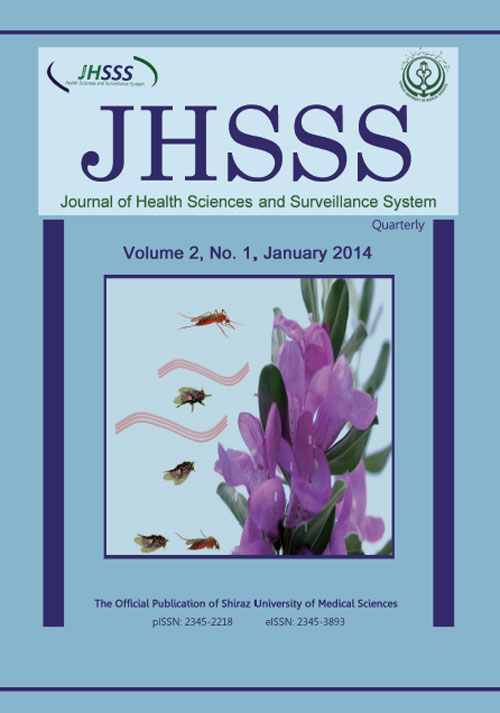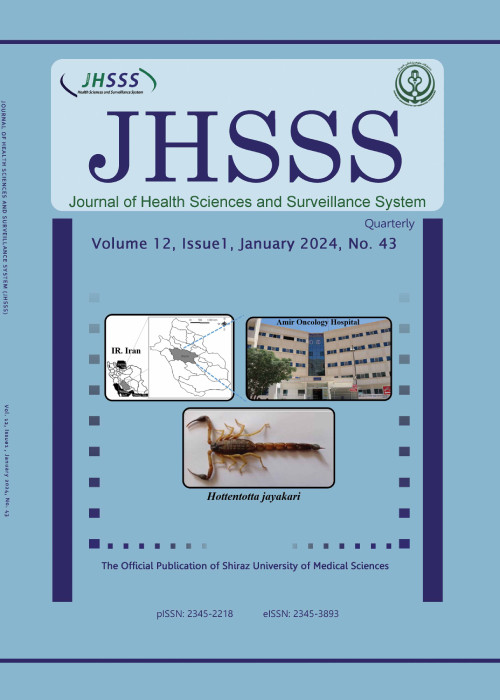فهرست مطالب

Journal of Health Sciences and Surveillance System
Volume:2 Issue: 1, Jan 2014
- تاریخ انتشار: 1392/11/10
- تعداد عناوین: 6
-
-
Pages 2-7BackgroundMedicinal plant extracts such as those obtained from Salvia species have a wide variety of chemical compounds in their essential oils. The repellency of a number of essential oils including those from the labiates like Salvia against several insect species including the common house flies is reported.ObjectiveThe aim of this investigation was to find out the excito-repellency effects of Salvia sclarea L. (Lamiaceae) extracts against adult house flies, Musca domestica L. (Diptera: Muscidae).MethodsAir-dried plant material from the aerial parts of S. sclarea was subjected to hydro-distillation in a Clevenger type glass apparatus model Soxhlet with acetone, benzene, petroleum ether, chloroform, and aqueous solvents. Only adult house flies were inserted into an exposure chamber and their behavior was monitored for feeding tendency, repellency rate and deterrence rate. Statistical analyses were carried out by one-way analysis of variance (ANOVA) with computation of the significance of differences in the outcome of various treatments.ResultsThere were significant differences among most of the various extracts with their controls in the sequential effects of feeding (P=0.04), deterrent (P=0.023) and repellency (P=0.01) rates of house flies. The order of potency for various extracts with a concentration of 100 g/l was as follows: petroleum ether> benzene> water> acetone> chloroform.ConclusionIt is thus conceivable to search for native means of combating house flies by fractionating the active ingredients in the Clary sage in the light of its excito-repellency effects.Keywords: Medicinal plant, House fly, Musca, Salvia extracts, Repellency
-
Pages 8-14BackgroundDiabetes Mellitus (DM) is closely associated with reduction of antioxidant defense system. In the present study, we investigated the antioxidant effect of quercetin supplementation on the glycemic control, lipid profile and oxidative stress indices in patients with type 2diabetes.MethodsForty seven patients with type 2 diabetes, aged 30-60 years old, were randomly assigned to supplement their daily diet with either an oral quercetin (250 mg/d) or identical placebo (cellulose) capsules for 8 weeks. The supplements were provided to the patients biweekly. Anthropometric data as well as glycemic indices, lipid profile and oxidative stress parameters of blood samples were determined at the baseline and endpoint of the study.ResultsDietary quercetin supplementation significantly improved the total antioxidant capacity (TAC) in the intervention group, when compared to the placebo group (P=0.043). It also resulted in a statistically significant reduction in serum concentration of atherogenic oxidized LDL (ox-LDL) (P0.05).ConclusionsOral quercetin supplementation was beneficial in improving the antioxidant status of patients with type 2 diabetes while having no other significant effect on glycemic control and lipid profile; however, conducting further studies, using different doses, on the glycemiccontrol and/or hyperlipidemia of thepopulation seems to be valuable.Keywords: Quercetin, Diabetes Mellitus, Insulin Resistance, Oxidative Stress, Dyslipidemia
-
Pages 15-25BackgroundAmoxicillin is widely used as an antibiotic in the modern medicine. Due to its chemical structure, polarity, activity level, antibiotic specifications, and environmental sustainability, Amoxicillin leaks into the groundwater, surface waters, and drinking water wells. Many physical and chemical methods have been suggested for removing Amoxicillin from aquatic environments. However, these methods are so costly and have many performance problems.MethodsIn this study, biodegradation of Amoxicillin by submerged biological aerated filter (SBAF) was evaluated in the aquatic environment. In order to assess the removal of Amoxicillin from the aquatic environment, this bioreactor was fed with synthetic wastewater based on sucrose and Amoxicillin at 3 concentration levels and 4 hydraulic retention times (HRTs).ResultsThe maximum efficiency for Amoxicillin and Soluble Chemical Oxygen Demand (SCOD) removal was 50.8% and 45.3%, respectively. The study findings showed that Stover- Kincannon model had very good fitness in loading Amoxicillin in the biofilter (R2 > 9 9%). T here w as n o a ccumulation o f Amoxicillin in the biofilm and the loss of Amoxicillin in the control reactor was negligible. This shows that removal of Amoxicillin from the system was due to biodegradation.ConclusionsIt can be concluded that there was no significant inhibition effect on mixed aerobic microbial consortia. It was also observed that Amoxicillin degradation was dependent on the amount of Amoxicillin in the influent and by increasing the initial Amoxicillin concentration, Amoxicillin biodegradation increased, as well.Keywords: Amoxicillin, Antibiotic, Biodegradation, Submerge Aerated Filter, Aquatic Environment
-
Pages 26-29BackgroundGiven the importance of birth weight and the effects of anthropometric indices and socioeconomic status on it, this study was conducted to assess birth weight and its related factors among infants born in the hospitals of Ahwaz Jondishapour University.MethodsThis cross-sectional study was carried out on 269 newly born babies and their mothers in hospitals of Ahwaz Jondishapour University during 2009. Neonate anthropometric measures were obtained from hospital reports. The mothers were asked about their weight before pregnancy, their weight gain and demographic and socioeconomic data. SPSS software version16 was used to analyze the data. Relationships among infants and mothers’ anthropometric indices were assessed using bivariate correlation.Results86.8% of the infants were normal as to weight, 8.7% were underweight, and 4.5% overweight. Mothers’ weight gain during pregnancy and BMI before pregnancy were 12.18±5.18(kg) and 24.75±4.78(kg/m2), respectively. There was a significant correlation between infant’s birth weight and mother’s weight, height and weight gain during pregnancy.DiscussionResults of this study showed that mothers’ weight before pregnancy and their pregnancy weight gain have a key role in infant birth weight, so controlling the mother’s weight gain according to recommendation has a great effect on infant’s health.Keywords: birth weight, pregnancy, weight gain
-
Pages 30-35BackgroundHuman malaria remains a major malady in Eastern Iran. Vector control interventions such as indoor residual spraying are used to fight with the disease. This study was undertaken to determine the lethal and residual effects of three different pyrethroid insecticides on adult mosquitoes of Anopheles stephensi on different surfaces in Iran, as part of a national program to monitor insecticide resistance in endemic areas.MethodsTwo main endemic foci were selected as collection sites. Wild adult females of An. stephensi (mysoriensis strain) from the first focus were subjected to standard susceptibility tests, using lambdacyhalothrin, deltamethrin and cyfluthrin insecticides within holding tubes according to the method proposed by WHO. In Kazerun, the residual effects of these compounds were examined by conical bioassay tests of An. stephensi (type strain) on plaster and cement walls. Data were analyzed using Mann-Whitney test to determine the differences in susceptibility and residual effects of An. stephensi mosquitoes to these insecticides.ResultsThe susceptibility of females of An. stephensi to three concentrations of lambdacyhalothrin, deltamethrin and cyfluthrin insecticides culminated in full scale mortality at the highest diagnostic dose. The maximal residual time of these three insecticides on plaster and cement walls was estimated to be about three months. There was no significant difference in the mortalities of An. stephensi on different sprayed surfaces (P=0.653).ConclusionAll field-collected An. stephensi populations exhibit gross susceptibility to all diagnostic doses of the three evaluated insecticides. In endemic areas, lambdacyhalothrin reveals a slightly longer residual activity than the other two insecticides.Keywords: Malaria, Vector, Anopheles, Pyrethroid, Insecticide
-
Pages 36-41BackgroundPre-chlorination of raw water containing natural organic matters may lead to forming harmful disinfection by-products such as trihalomethanes (THMs), the measurement of which needs expensive advanced analytical instruments. This study was conducted to anticipate THMs formation potential in Bandar Abbas drinking water system using cheap and simple experiments and a mathematical model.MethodsIn a 24 week sampling program, 96 samples were collected weekly from raw water (RW), clarification (CE), filtration (FE), and disinfection effluent (DE). After measuring the Dissolved Organic Carbon (DOC), residual chlorine, contact time, temperature and pH of water, THMs concentration was calculated using a mathematical model.ResultsThe means of DOC concentration in RW, CE, FE and DE were 5.56, 4.21, 3.50, and 3.01 (mg/l), respectively. The mean of temperature values varied from 22.28 in RW to 21.25 in DE and the mean of pH variations was measured from 6.75 in DE to 8.37 in CE. Also, the mean of residual chlorine concentration was 0.0 to 1.72 in RW and DE, respectively.ConclusionThe means of calculated THMs were 37.92±4.82μg/l, 51.15±9.44μg/l, and 52.71±8.37μg/l for CE, FE, and DE respectively; this did not meet the related EPA standard (30- 40μg/l); therefore, further detailed studies should be conducted to resolve the consumers’ concerns in this regard.Keywords: Organic Matters, Disinfection by, Products, Trihalomethanes, Prediction model


